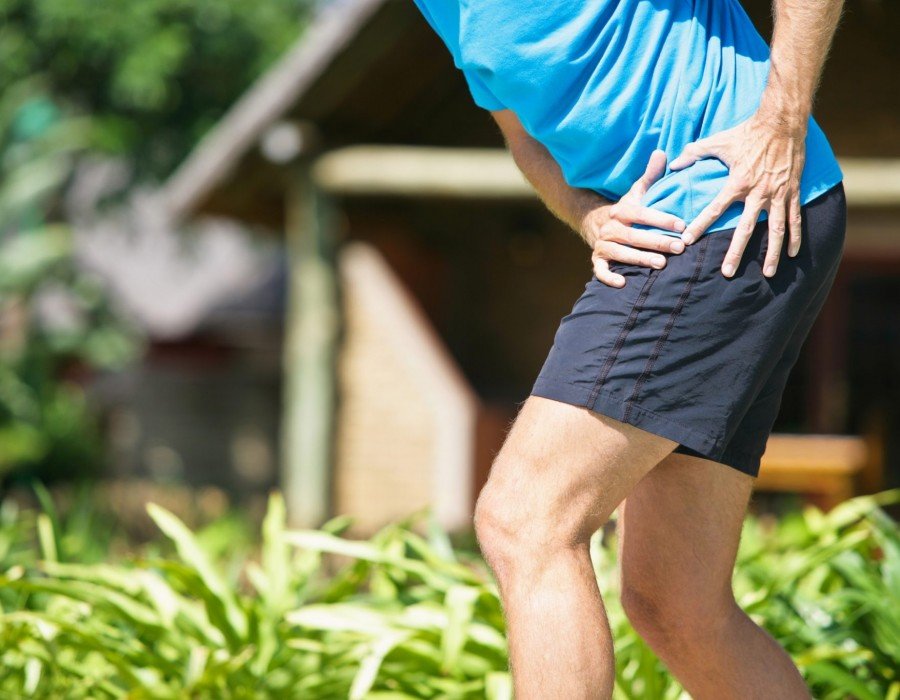Health and Wellbeing
Why do I have hip and groin pain?

Do you suffer from hip and groin pain? If so you’ll know just how painful and debilitating it can be. Today, Bodyset’s physiotherapist Shelly shares her expert knowledge of the causes of hip and groin pain. We’ll also gives you invaluable advice and techniques on how to treat and ease your pain so you can continue your life, pain-free.
Why do I have hip and groin pain?
The hip joint is one of the most flexible joints of the body. Yet it has very good stability due to its complex network of muscles, tendons and ligaments. It acts as a junctional joint which transmits forces from the spine (the axial skeleton) to the limbs, and vice versa. As a result, the joint regularly bears a lot of stress and can eventually suffer from wear and tear.
Symptoms
The pain you experience can differ according to the specific structures affected, your age and your day-to-day routine.
Location
The area in which you predominantly experience pain can point towards the specific structure affected. Hip pain can be anterior (the groin region), lateral (the side of hip into the pelvis) or posterior (buttock region).
Age
Certain developmental conditions are more predominant in specific age groups.
In children between three and 14 years of age, we most often see slipped capital femoral epiphysis, leg calf perthes, septic arthritis and transient synovitis.
In middle-aged clients (post-skeletal maturation) hip and groin pain is usually due to muscle strain, inflammation of the joint capsule, tendons, ligaments and bursae, post-trauma or biomechanical problems.
For the older population, pain is usually due to osteoarthritis of the hip or because of a stress fracture.
Onset of pain
Pain usually occurs after a change in activity. For example, active people may notice pain after: increasing the time spent walking or running; changing their terrain (a treadmill vs ground vs uphill run); after having an injury elsewhere such as in the lower spine, knee or ankle; or having taken up a new sport.
Associated symptoms
As well as pain, you may experience clicks, snaps or numbness in the hip and groin region. It is essential to note where these occur as they are a good indicator of the structures involved. Clicks and snaps are usually due to ligaments and bursae while numbness usually indicates neural involvement from lumbar spine.
Common causes of hip pain:
| Bone | Ligaments and Tendons | Muscles | Capsule | Referred pain |
|---|---|---|---|---|
| Joint degeneration or OA, Femoral neck- stress fracture | Athletic Pubalgia-Sports hernia, Bursitis, Tendonitis | Hip flexors- iliopsoas, rectus femoris Adductor or Oblique strain, Abdominal strain, Sartorius overuse, Gluts and Pelvic floor muscle weakness | Labral (joint capsule) tears, Loose bodies, Femoral-Acetabular Impingement (FAI) Joint inflammation (Synovitis) | Spine- higher lumbar nerve root affected, Sacroiliac/coccyx strain, Neuropathy- pudendal, genitofemoral, obdurator nerve, Gynaecological, kidney or urological issues Abdominal hernia |
How do I fix it?
If you are suffering from hip and groin pain it’s important that you do not ignore your symptoms. Book an appointment with a health professional to get yourself checked out and to understand the structures involved.
Clinical assessment forms the basic evaluation and, depending on the duration and severity of affection, you’ll be referred for X-Ray, MRI or Ultrasound investigations.
Treatment
Correction usually takes six to eight weeks, with conservative treatment.
If your hip pain is caused by hip overload or overuse, it can often be corrected by modification to your training routine. Make sure you consult a qualified physiotherapist for a bespoke plan.
Primary frameworks for rehabilitation include:
- Rest and cold compress
- Regaining appropriate muscle balance – strengthening weak muscles and stretching/soft tissue release for the overloaded ones
- Enhancing better pelvis and lumbar stability
- Core muscle activation
- Understanding your body’s demands and training isolated muscles
- Correcting poor posture e.g. slouched lumbar or thoracic region, improper pelvic tilts
- Use of proper footwear including arch support, insoles
- Biomechanical assessments such as running technique, exercise forms, sport-specific training
- Balance and stability exercises
- Agility training and plyometrics
Identifying the signs and symptoms of hip and groin pain early on is essential. Along with clinical help, this will help prevent the worsening of symptoms. Early treatment will also allow you a faster recovery, avoid future recurrences and ensure that your life does not revolve around pain and disability.